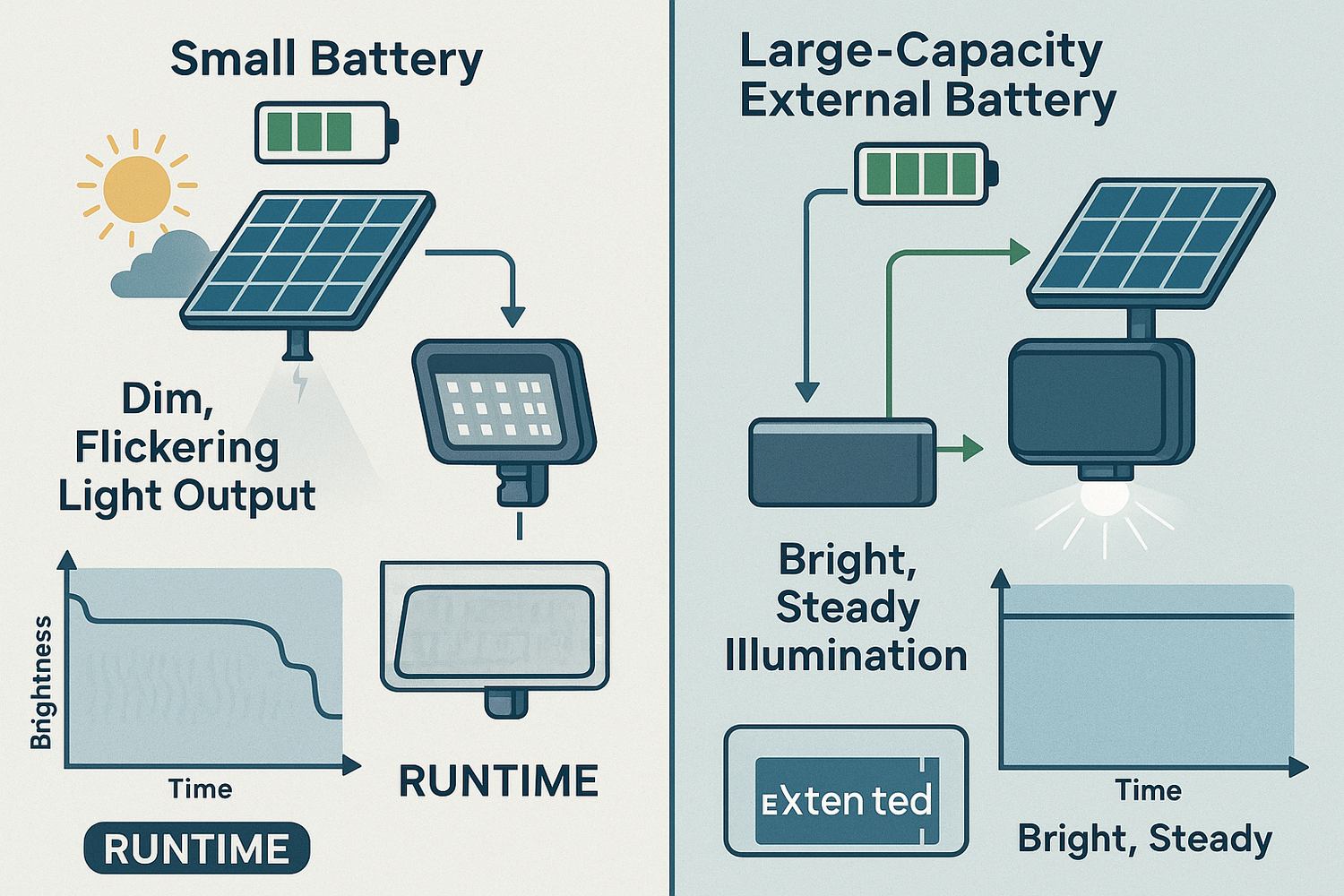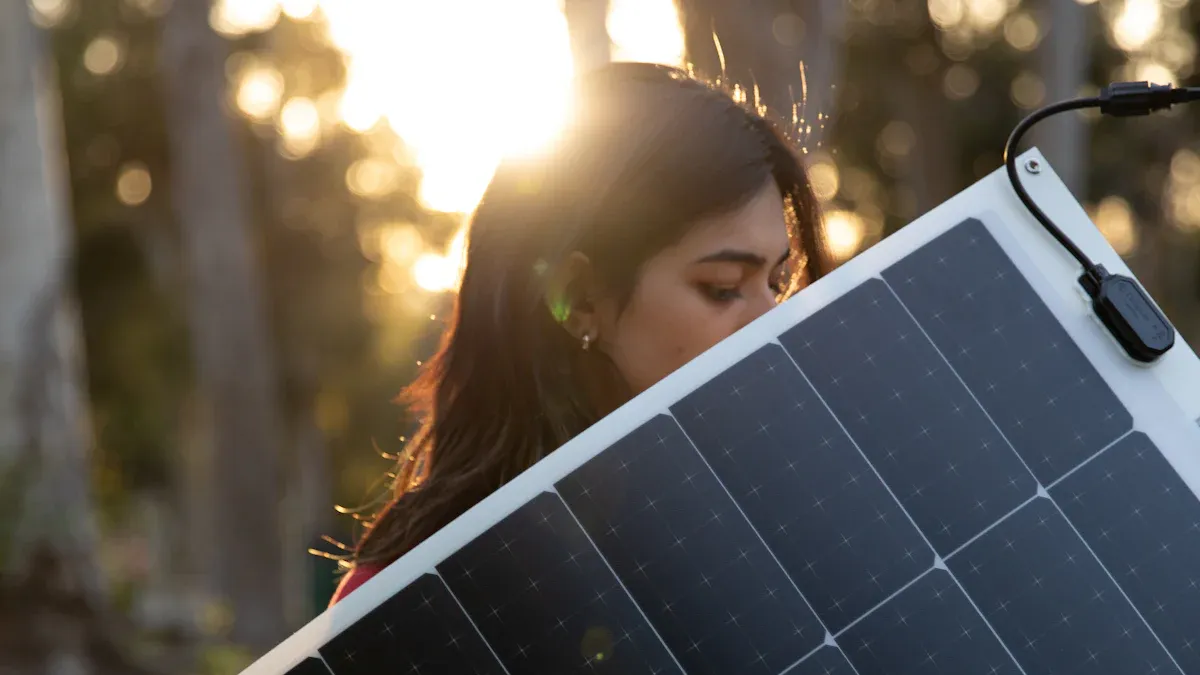
Large-Capacity External Batteries can make a big difference in how your solar lights perform. You’ll notice longer run times, brighter light, and more reliable operation, especially during cloudy weather or power outages. High-capacity batteries let your lights run for two days or more without sunlight, far outlasting standard options. You might wonder about compatibility or setup, but modern designs make installation easy and maintenance-free. If you want dependable, hassle-free lighting, you’ll find real value in upgrading.
Key Takeaways
- Large-capacity external batteries extend solar light run times, providing reliable lighting even during cloudy days or power outages.
- Battery capacity, measured in mAh or Wh, determines how long your solar light can operate after sunset.
- High-capacity batteries keep solar lights bright and steady all night, preventing flickering or sudden dimming.
- Choosing the right battery involves matching capacity, chemistry, and voltage to your solar panel and light system.
- Modern large-capacity batteries like LiFePO4 offer long lifespans, fast charging, and weather resistance for outdoor use.
- Proper installation and regular maintenance, such as cleaning panels and checking connections, maximize solar light performance.
- Portable solar chargers provide flexible power for short-term or mobile use, while fixed high-capacity systems suit large or continuous lighting needs.
- Combining a high-quality solar panel, large-capacity battery, and smart controls delivers the best brightness, reliability, and energy efficiency.
Battery Capacity and Solar Light Performance
What Is Battery Capacity?
When you look at solar lights, you’ll see numbers like mAh, Wh, or Ah on the battery label. These numbers tell you how much energy the battery can store. Think of battery capacity as the size of a fuel tank for your solar light. The bigger the tank, the longer your light can run before it needs more energy from the solar panel.
mAh and Wh Explained
You’ll often see battery capacity measured in milliampere-hours (mAh) or watt-hours (Wh). Here’s what those mean for you:
- mAh shows how much electric charge the battery can hold. Higher mAh means more stored energy.
- Wh tells you how much actual work the battery can do. It combines voltage and current, giving you a better idea of real-world performance.
- For solar lights, you might also see ampere-hours (Ah) or even kilowatt-hours (kWh) in bigger systems.
- The battery stores energy collected by the solar panel during the day. At night, your light uses this stored energy to shine.
- If you use a large-capacity panel and a bigger battery, you get more stored energy and longer lighting times.
So, when you shop for solar lights, pay attention to both the battery capacity and the solar panel size. These two work together to decide how long and how brightly your light will shine.
Impact on Run Time
Battery capacity has a direct effect on how long your solar light stays on after sunset. If you have a higher battery capacity, your light can run for more hours—even if the weather is cloudy or the days are short. The solar panel charges the battery during the day, and the stored energy powers your light at night.
Let’s look at some real-world numbers:
|
Battery System |
Capacity (kWh) |
Estimated Backup Duration (hours) |
|---|---|---|
|
Tesla Powerwall |
13.5 |
12 - 15 |
|
Sunrun Brightbox |
10 |
10 - 12 |
You can see that as battery capacity goes up, so does the backup duration. The same rule applies to solar lights. If you use a large-capacity panel with a high-capacity battery, your lights can run for several nights without needing a recharge. This is especially helpful during storms or long stretches of cloudy weather.
Rackora’s 2025 Super High Power Solar LED Stadium Light is a great example. It uses a 25AH LiFePO4 battery and a 120W monocrystalline solar panel. This setup lets the light run for days, even when the sun doesn’t shine. You get reliable lighting for big spaces like stadiums, parks, or event venues.
Brightness and Consistency
You want your solar lights to stay bright and steady all night. Battery capacity plays a big role here. If the battery runs low, the light might start to flicker or dim. Sometimes, it might even shut off suddenly. That’s not what you want when you need reliable lighting.
Here’s how battery capacity affects brightness and consistency:
- A bigger battery keeps the power output stable, so your light stays bright from dusk till dawn.
- If the battery gets old or loses capacity, you might notice flickering or shorter run times.
- The solar panel needs to charge the battery fully each day. If you have a large-capacity panel, it can collect more energy, helping the battery stay topped up.
- Regular maintenance and timely battery replacement help keep your lights shining bright.
Rackora’s stadium light uses a high-capacity battery and a powerful solar panel. This combo means you get 10,000 lumens of steady, bright light, even in tough weather. The light’s design ensures consistent power output, so you don’t have to worry about flickering or sudden blackouts.
Tip: If you want your solar lights to last longer and shine brighter, choose models with a large-capacity panel and a high battery capacity. This way, you get the most out of your solar lighting investment.
Reliability Factors
When you think about solar lights, you probably want them to work every night, no matter what the weather looks like. Reliability matters most when you depend on outdoor lighting for safety, security, or important events. Several factors play into how reliable your solar lights will be, but battery capacity sits at the top of the list.
A large battery capacity gives your solar light a bigger energy reserve. This means your light can handle cloudy days, rainy weeks, or even a few days without much sun. You won’t have to worry about your lights going out just because the weather changes. Here’s what you should keep in mind:
- Weather Resistance: If you live in a place with unpredictable weather, a higher battery capacity helps your lights stay on through storms and overcast days.
- Consistent Performance: Lights with more stored energy deliver steady brightness. You won’t see them dim or flicker as the night goes on.
- Long-Term Durability: High-quality batteries, like the LiFePO4 used in Rackora’s 2025 Super High Power Solar LED Stadium Light, last longer and hold their charge better over time. This means fewer replacements and less hassle for you.
Note: If you want your solar lights to work every night, even in tough conditions, always check the battery capacity before you buy.
Let’s look at a real-world example. Rackora’s stadium light uses a 25AH LiFePO4 battery. This large battery capacity lets the light run for up to 5-7 days, even if the sun doesn’t come out. You get peace of mind knowing your space stays lit, whether you’re hosting a big game or just keeping your property safe.
Reliability also depends on the quality of the solar panel, the efficiency of the LED, and the overall design. But if you start with a high battery capacity, you set yourself up for success. You’ll spend less time worrying about outages and more time enjoying bright, dependable light.
Large-Capacity External Batteries
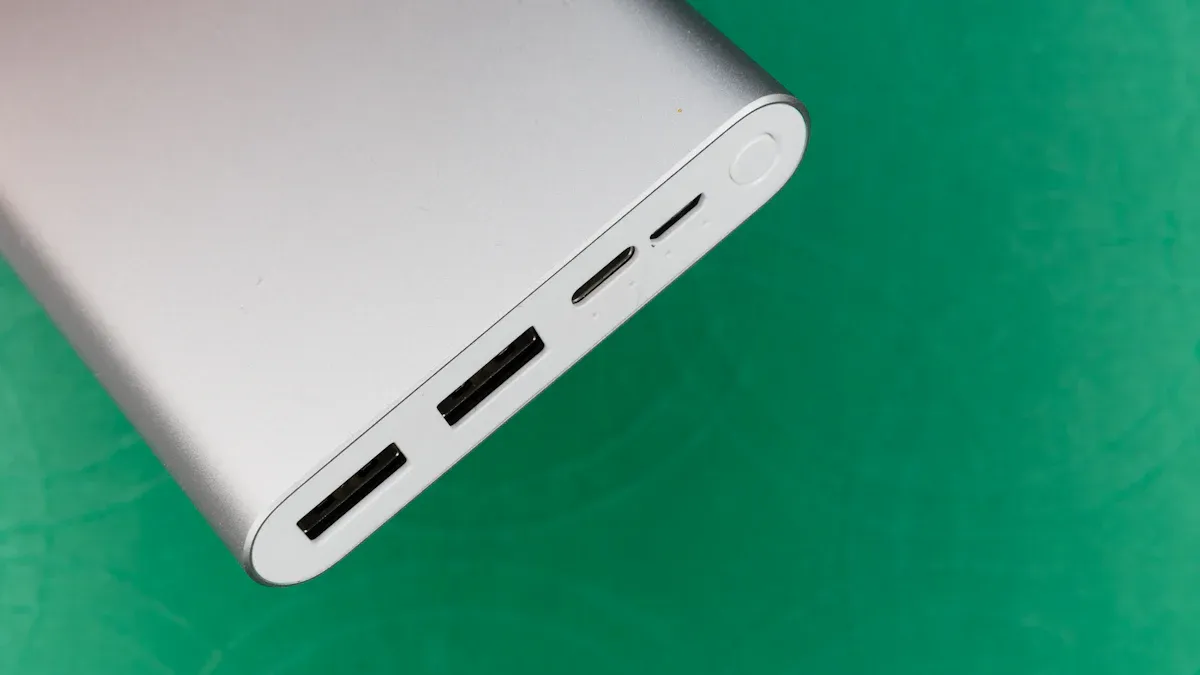
Benefits for Solar Lights
When you use large-capacity external batteries with your solar lights, you unlock a whole new level of performance. These batteries give your lights the energy they need to shine bright and stay on longer, even when the weather doesn’t cooperate. You might wonder why so many people choose a large-capacity external battery for their solar lighting setup. Here’s what you gain:
- Reliable power for your LED lights during camping trips, emergencies, or remote work.
- Several days of backup lighting, so you never worry about running out of light after a cloudy week.
- Long lifespan—some batteries last up to 10 years, which means less electronic waste and fewer replacements.
- Fast charging, with some models reaching 80% in just a couple of hours.
- Multiple output ports, letting you power different devices at once.
- Clean, stable power output that keeps sensitive electronics safe.
- Compatibility with solar charging, so you can run your system entirely on renewable energy.
- Modular designs and solid warranties, making repairs and upgrades easy.
Modern solar charger technology packs more energy into smaller, lighter batteries. You get more storage without bulky equipment. Intelligent battery management systems help you get the most out of every charge, making your setup more cost-effective and sustainable. If you want the best results, pair your solar panel with a large-capacity external battery and a high-quality solar charger. This combination gives you energy independence, grid support, and the best reliability for your outdoor lighting.
Tip: If you want your solar lights to work through storms, power outages, or long nights, always choose a large-capacity external battery and the best solar charger you can find.
Choosing the Right Battery
Picking the right battery for your solar lighting system can feel overwhelming. You see so many options—different sizes, chemistries, and brands. Here’s how you can make the best choice for your needs:
- Check Your Power Needs: Figure out how much energy your lights use each night. Look at the wattage of your LED, the number of hours you want the light to run, and the total power output you need.
- Match the Battery to Your Panel: Make sure your battery can store all the energy your solar panel collects during the day. If your panel produces more energy than your battery can hold, you waste potential power.
- Look for High Energy Density: The best batteries store a lot of energy in a small, lightweight package. This makes installation easier and keeps your setup neat.
- Think About Lifespan: Choose a battery with a long cycle life. Lithium iron phosphate (LiFePO4) batteries are a great choice—they last longer and handle more charge cycles than standard batteries.
- Consider Charging Speed: Fast-charging batteries let you get ready quickly, especially if you use your solar charger in changing weather.
- Check for Multiple Outputs: If you want to power more than just your lights, pick a battery with several output ports. This lets you run other devices from the same charger.
- Weather Resistance: Outdoor solar lighting needs batteries that can handle rain, dust, and temperature swings. Look for waterproof ratings like IP66 for the best protection.
Here’s a quick table to help you compare features:
|
Feature |
Why It Matters |
What to Look For |
|---|---|---|
|
Capacity (Wh/Ah) |
Determines run time |
High numbers for longer use |
|
Energy Density |
Easier installation |
Compact, lightweight design |
|
Lifespan |
Fewer replacements |
5-10 years or more |
|
Charging Speed |
Quick readiness |
80% charge in 2-3 hours |
|
Output Ports |
Power multiple devices |
Multiple AC/DC/USB outputs |
|
Weather Resistance |
Outdoor durability |
IP66 or higher |
When you combine the best solar charger, a high-capacity panel, and a large-capacity external battery, you get a system that works in any situation. You won’t have to worry about your lights going out, even if the weather turns bad or you’re far from the grid.
Rackora Product Example
Let’s talk about how Rackora’s 25AH LiFePO4 battery takes solar lighting to the next level. You get up to 24 hours of backup lighting, so your space stays bright even after several cloudy days. The system’s IP66 waterproof rating means you don’t have to worry about rain, flooding, or dust. The sealed battery compartment keeps water out, making the whole setup tough enough for any weather.
You’ll love how easy it is to replace the battery—no special tools needed. This user-friendly design means less time on maintenance and more time enjoying reliable light. The system runs completely off-grid, so you keep your lights on during power outages without missing a beat.
Rackora’s solar charger and panel work together with the 25AH battery to deliver the best performance. You get silent operation, zero emissions, and no fuel costs. The system proves itself in real-world conditions, running through storms, floods, and grid failures with almost no maintenance. Compared to traditional generators, you get better reliability, cleaner energy, and a much quieter experience.
Note: If you want the best in outdoor solar lighting, Rackora’s 25AH LiFePO4 battery and solar charger system give you the power, durability, and convenience you need. Pair it with a high-efficiency panel for the best results.
Compatibility and Installation
Checking Requirements
Before you connect a large-capacity external battery to your solar light, you need to check a few things. Not every battery works with every light. If you skip this step, you might damage your system or get poor performance.
Here are some common compatibility issues you should watch for:
- Most solar lights use batteries with voltages of 3.2V or 3.7V. If you use a battery with higher voltage, you risk damaging the light’s circuitry.
- Battery chemistry matters. Lithium iron phosphate (LiFePO4), ICR, and INR batteries have different voltages and discharge rates. Always match the chemistry to your solar light’s requirements.
- Oversized batteries (above 2500mAh) may not fully charge or could overheat if your light’s circuitry only supports lower capacities.
- Mixing brands or battery types can cause unstable performance. Stick with one brand and chemistry for best results.
- Choose batteries with PCM protection. This feature helps prevent overcharging, over-discharging, and short circuits.
Tip: Always check your solar light’s manual for recommended battery specs before you buy a new charger or battery.
Installation Tips
Getting your solar light system set up is easier than you think. You just need to follow a few simple steps to make sure everything works smoothly.
- Pick a sunny spot for your solar panel. Avoid shade from trees, buildings, or anything else that blocks sunlight.
- Mount the panel securely. Use the adjustable bracket to aim it toward the sun for maximum energy collection.
- Place the battery and charger in a safe, dry location. Keep them away from water and direct sunlight to extend their lifespan.
- Connect the charger to the battery and the solar panel. Make sure all connections are tight and secure.
- Test the system by turning on the light. If it works, you’re good to go.
Here’s a quick table to help you remember the key steps:
|
Step |
What to Do |
|---|---|
|
Panel Placement |
Find a sunny, unobstructed spot |
|
Mounting |
Use bracket for best angle |
|
Battery Location |
Keep dry and safe |
|
Charger Connection |
Secure all wires |
|
System Test |
Turn on light and check function |
Note: If you use a Rackora system, installation is straightforward. The adjustable bracket and easy-access battery compartment make setup quick and hassle-free.
Troubleshooting
Sometimes, things don’t go as planned. If your solar light isn’t working right, you can fix most problems yourself. Here are some troubleshooting steps you can try:
- Inspect your solar light every month. Look for damage, corrosion, or low battery charge.
- Replace the battery when needed. Old batteries lose capacity and can cause dim or flickering lights.
- Clean the solar panel and light cover often. Dirt blocks sunlight and reduces charging efficiency.
- Keep a log of maintenance activities. This helps you spot patterns and catch problems early.
- If your light won’t turn on, check the charger and battery connections. Loose wires are a common cause.
- For sensor or control issues, reset the system or check for software updates if available.
- If you notice weather-related problems, make sure your panel and charger are protected from rain and dust.
- Test your system after installation by simulating a power outage. Make sure the light activates automatically.
Tip: Choose lithium iron phosphate batteries for the best reliability. They last longer and handle more charge cycles than other types.
Routine cleaning and battery checks every few months will keep your solar lighting system running smoothly. If you ever need help, Rackora’s support team is ready to assist.
Portable Solar Charger Options
What Is a Portable Solar Charger?
You might have seen a portable solar charger on a camping trip or at an outdoor event. This handy device uses a small solar panel to turn sunlight into electricity. You can carry it in your backpack or even attach it to your tent. Most portable solar chargers are lightweight and compact, so you can take them anywhere. They usually have a built-in battery bank, which stores energy for later use. You can use a portable solar charger to power your phone, smartwatch, or even a small light.
Portable solar chargers usually range from 1 watt up to about 50 watts. Some models go a bit higher, but they stay small enough for easy transport. The solar panel on these chargers works best in direct sunlight, but it still charges slowly if clouds roll in. You won’t get the same speed or power as a big, fixed solar panel, but you gain flexibility and freedom.
Here’s a quick comparison to help you see the difference:
|
Feature |
Portable Solar Chargers |
Fixed High-Capacity Battery Solutions |
|---|---|---|
|
Size and Weight |
Small, lightweight, easy to carry |
Larger, heavier, usually stationary |
|
Wattage Range |
1W to ~50W (some up to 100W+) |
Often over 100W |
|
Intended Use |
Phones, smartwatches, small lights |
Large electronics, multiple devices, base camps |
|
Portability |
Designed for travel and quick setup |
Fixed setup, not for frequent moving |
|
Battery Integration |
Built-in, limited capacity |
Large battery banks, high storage |
|
Charging Speed |
Slower, depends on sunlight |
Faster, more consistent |
|
Use Case Examples |
Backpacking, hiking, emergency charging |
Boondocking, stadiums, off-grid living |
Use Cases for Solar Lights
You can use a portable solar charger in many situations. If you love camping, a solar panel for camping lets you keep your lights and gadgets powered up. When you hike or backpack, a portable solar charger fits right in your bag. It gives you peace of mind if your phone or flashlight runs low. During emergencies, a portable solar charger can keep your solar lights on when the grid goes down.
Here are some common ways people use portable solar chargers with solar lights:
- Lighting up tents or campsites at night
- Charging emergency lanterns during power outages
- Powering small garden lights in remote areas
- Keeping pathway lights on during outdoor events
- Providing backup power for security lights in temporary setups
A portable solar charger works best for short-term needs or when you move around a lot. You get flexibility, but you trade off some power and speed. If you want something for a weekend trip or a quick fix, a portable solar charger is a smart pick.
Rackora and Portable Solutions
Rackora offers both portable solar solutions and fixed high-capacity products. If you want a quick, flexible setup, Rackora’s portable solar chargers use lithium iron phosphate batteries that last over five years. These chargers use standard photovoltaic cells, so you get reliable performance in a small package. You can use them for emergency lighting, camping, or any time you need a fast, portable power source.
If you need more power, Rackora’s fixed high-capacity products shine. The 2025 Super High Power Solar LED Stadium Light uses a high-efficiency monocrystalline solar panel and a large LiFePO4 battery. This setup gives you backup lighting for up to two days, even in bad weather. You get advanced features like smart controls, motion sensors, and remote monitoring. The weather-resistant design (IP66) means you can trust it outdoors, year-round.
Here’s a side-by-side look at how Rackora’s portable solar chargers compare to their fixed high-capacity solutions:
|
Feature |
Portable Solar Solutions |
Fixed High-Capacity Products |
|---|---|---|
|
Battery Type |
LiFePO4, 5+ years lifespan |
High-capacity LiFePO4 |
|
Solar Panels |
Standard, portable |
High-efficiency monocrystalline |
|
Backup Duration |
Moderate, short-term outages |
Up to two days, long-term use |
|
Lighting Technology |
Energy-efficient LEDs |
High-quality LEDs for large areas |
|
Smart Controls |
Basic or none |
Advanced (motion, remote, monitoring) |
|
Weather Resistance |
Portable, less weatherproof |
IP65/IP66, outdoor durability |
|
Application Focus |
Flexibility, quick setup |
Continuous, large-scale lighting |
If you want a portable power station for your next adventure, Rackora’s portable solar charger gives you the freedom to go anywhere. For stadiums, parks, or big events, the fixed high-capacity system delivers unmatched performance and reliability. You can choose the best solar charger for your needs, whether you want an affordable solar panel for camping or a robust solution for your property.
Tip: Think about how you plan to use your solar charger. If you move around a lot, go portable. If you need steady, powerful lighting, choose a fixed high-capacity system.
Best Solar Charger Features
Key Qualities
When you look for the best solar charger for your outdoor lighting, you want features that make your life easier and your lights brighter. The best solar charger should give you reliable power, quick charging, and long-lasting performance. Here’s what you should keep an eye on:
- Brightness and lumen output: The best solar charger supports high lumen output, so your lights stay bright all night. For outdoor spaces, you want at least 500 lumens, but bigger areas may need 2000 lumens or more.
- Battery capacity and charging time: A large battery means your solar charger can run longer. The best solar charger balances big capacity with fast charging, so you don’t wait around for your panel to refill the battery.
- Durability and weather resistance: Outdoor use demands a solar charger that stands up to rain, snow, and heat. Look for a high IP rating to keep your charger safe.
- Solar panel size and wattage: Bigger panels collect more sunlight. The best solar charger uses a panel with at least 100W for large setups.
- Charging speed in direct and indirect sunlight: You want a charger that works fast in full sun and still performs on cloudy days.
- Portability: If you move your lights often, a lightweight solar charger with a compact panel makes setup simple.
- Functionality: The best solar charger offers easy setup, smart cable management, and adjustable panels to catch the most sun.
- Multiple device charging: Some chargers let you power several lights or gadgets at once, which is handy for events or group camping.
Tip: Always check the specs for battery size, panel wattage, and weatherproofing before you pick the best solar charger for your needs.
Comparing Brands
You’ll find many brands claiming to offer the best solar charger, but not all deliver the same results. Let’s see how top brands stack up for efficiency, power, and reliability:
|
Brand |
Efficiency |
Max Power Output (W) |
Warranty (Product + Performance) |
Reliability Features |
|---|---|---|---|---|
|
REC Alpha Pure-RX |
Up to 22.6% |
Up to 460 |
25 years (product, performance, labor) |
Advanced HJT tech for heat/shade performance; durable build for harsh weather |
|
Silfab Prime/Elite |
Around 21.4% |
400–440 |
25 years product + 30 years performance |
Certified for heavy snow and wind; premium materials and strict quality control |
|
QCell Q.ANTUM DUO |
Around 21% |
400–440 |
25 years product and performance |
Consistent performance in varied conditions; tested for snow, wind, moisture |
|
DMEGC Infinity |
23% |
440–460 |
25 years product + 30 years degradation warranty |
Long lifespan with 87.4% output after 30 years; Tier-1 manufacturer reliability |
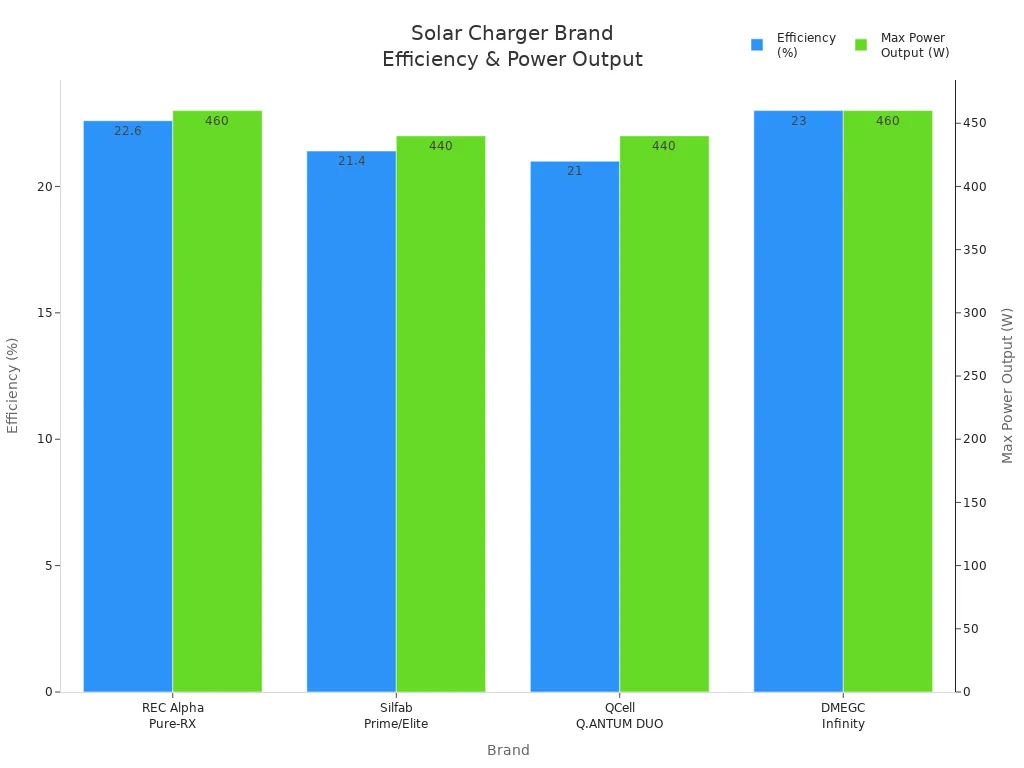
DMEGC Infinity panels stand out with high efficiency and long-term reliability. You get a solar charger that keeps working for decades, making it a smart investment for outdoor lighting.
Rackora’s Approach
Rackora takes the best solar charger features and brings them together in one package. You get a high-capacity battery, a powerful solar panel, and a charger built for the outdoors. The 2025 Super High Power Solar LED Stadium Light uses a 25AH LiFePO4 battery and a 120W monocrystalline solar panel. This combo gives you bright, steady light—up to 10,000 lumens—even after days of clouds.
Rackora’s charger charges quickly in direct sun and keeps going in cloudy weather. The panel’s adjustable bracket helps you catch the most sunlight. The charger’s IP66 rating means rain, dust, and snow won’t slow you down. You can set up the best solar charger in minutes, and the easy-access battery compartment makes maintenance simple.
You also get the flexibility to power multiple devices, thanks to smart design and high output. Rackora’s focus on quality and user-friendly features means you spend less time worrying about your solar charger and more time enjoying bright, reliable outdoor lighting.
Note: If you want the best solar charger for your outdoor space, Rackora’s system gives you the power, durability, and convenience you need.
Portable Power Stations for Solar Lighting
When to Use
You might wonder when portable power stations make the most sense for solar lighting. These stations step in when you need reliable power away from the grid. If you’re planning a picnic, fishing trip, or road adventure, a solar charger paired with a portable power station keeps your lights and devices running. You get silent, eco-friendly energy that works anywhere.
Here’s a quick look at common scenarios:
|
Scenario |
Typical Devices |
Recommended Output |
Battery Capacity |
|---|---|---|---|
|
Picnic |
Smartphones, Bluetooth speakers, LED lights |
200–400W |
200–300Wh |
|
Fishing Trip |
Portable fridge, fish finder, LED lights, aerator pumps |
500–800W |
500–600Wh |
|
Road Trip |
Laptop, coffee maker, CPAP machine, projector |
800–1500W |
1000+Wh |
You can see that each situation calls for a different size solar charger and panel. For a picnic, you only need a small solar power station. If you’re heading out for a longer trip, you’ll want a bigger charger and panel to keep everything powered.
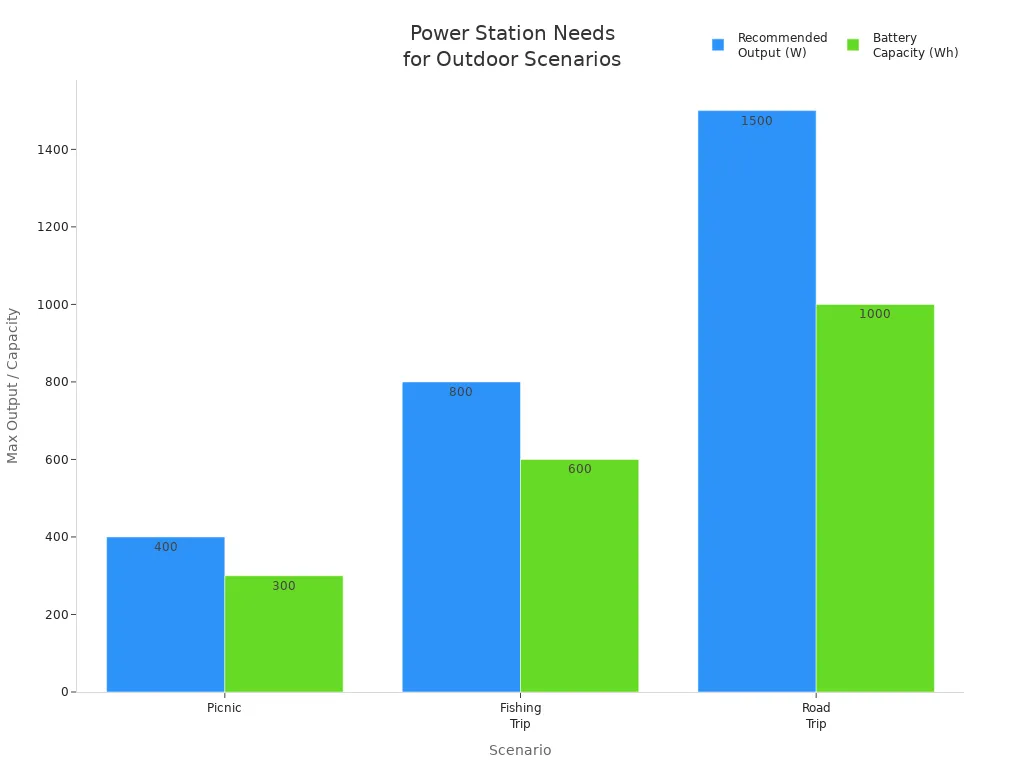
Portable power stations shine in outdoor and emergency power situations. You get continuous lighting even if the weather changes or the grid goes down. Solar charging lets you extend your trip without worrying about running out of energy.
Pros and Cons
Portable power stations offer plenty of benefits for solar lighting, but you should know about a few trade-offs. Here’s what you get:
- Quiet operation, so you won’t disturb your surroundings. The noise level matches a mini fridge.
- Easy to carry, with handles and wheels. You can move your charger and panel wherever you need.
- Multiple charging options. Use a solar panel, AC outlet, or car outlet. Hybrid models let you switch between solar charger and electric charging.
- Safety features like automatic shutdown, overload protection, and temperature gauges. Your devices stay safe.
- Water and UV resistance. You can use your charger and panel outdoors without worry.
But there are a few things to keep in mind:
- Some portable power stations feel heavy, especially if you choose a larger model.
- Limited power output. You can’t run high-demand appliances with every charger.
- Solar charging depends on the right panel and good weather. Cloudy days slow things down.
- Some models lack special outlets, like 30-amp RV plugs.
- Occasionally, display units need calibration.
You get a balance between portability, power, and convenience. For most outdoor uses, a solar charger and portable power station give you dependable lighting and emergency power.
Integration with Rackora Lights
You can pair portable power stations with Rackora’s stadium light and other solar lighting products for flexible setups. If you need temporary lighting for an event, a solar charger and portable power station work together to keep your lights on. The charger collects energy from the solar panel and stores it in the power station. You get backup lighting for hours, even if the weather turns bad.
Rackora’s stadium light uses a high-capacity LiFePO4 battery and a powerful solar panel. You can connect a portable power station for extra backup during emergencies. The charger’s smart controls and weather-resistant design make integration easy. You don’t need special tools or complicated wiring. Just connect the charger, panel, and power station, and you’re ready to go.
If you want to light up a sports field, garden, or outdoor event, you can rely on Rackora’s system. The solar charger and portable power station give you silent, clean energy. You get peace of mind knowing your lights will stay on, no matter what happens. For off-grid living or emergency power, this setup delivers reliable performance.
Tip: Always check your solar panel and charger specs before connecting to a portable power station. You’ll get the best results when everything matches up.
Real-World Scenarios
Who Benefits Most
You might wonder who gets the most out of large-capacity external batteries for solar lights. If you manage a sports field, run outdoor events, or need reliable lighting for public spaces, you’ll see the biggest impact. Homeowners with large gardens or security needs also benefit. When you use a high-capacity battery with a quality panel, you get multi-day autonomy. That means your lights stay on even during long stretches of cloudy weather. Municipalities and facility managers love the resilience these systems offer. You don’t have to worry about grid instability or sudden outages. Rackora’s stadium light, with its robust battery and efficient panel, shines in these demanding environments. You get the best performance for safety, visibility, and peace of mind.
Maximizing Performance
You want your solar lights to work their best every night. Here are some strategies that help you get the most out of your system:
- Place your panel where it gets direct sunlight, especially between 10 AM and 3 PM.
- Orient the panel south if you live in the Northern Hemisphere. Adjust the tilt for your latitude and the season.
- Clean your panel regularly. Dust and debris can cut output by up to 30%.
- Use lithium batteries with overcharge and over-discharge protection. These last longer and perform better in cold weather.
- Invest in smart energy management systems. They optimize charging and discharging, so you get the best efficiency.
- Choose monocrystalline panels with MPPT controllers. These offer the best charging rates and battery health.
- Monitor your system during winter or cloudy periods. Adjust the panel’s position or upgrade components if needed.
- Separate the panel from the light fixture if possible. This lets you place the panel in the sunniest spot, even if the light is shaded.
Tip: The best results come from combining a high-quality panel, advanced lithium battery, and smart controls. You’ll see longer run times and brighter lights.
User Tips
You can keep your solar lighting system running at its best with a few simple habits. Check out these practical tips from real users:
|
Aspect |
Practical Tip / User Advice |
Reason / Benefit |
|---|---|---|
|
Battery Type |
Use lithium batteries instead of Ni-MH |
Lasts twice as long; better cold resistance |
|
Battery Protection |
Ensure overcharge and over-discharge protection |
Prevents battery damage and extends lifespan |
|
Solar Panel Maintenance |
Clean panels weekly with a white vinegar solution |
Dust can reduce output by 30% |
|
Sunlight Exposure |
Ensure 6-8 hours of direct sunlight; trim trees or overhangs |
Maximizes charging efficiency |
|
Battery Replacement |
Replace rechargeable batteries every 18 months |
Maintains battery performance |
|
Housing Material |
Avoid plastic housings; choose stainless steel or aluminum |
Prevents UV damage and yellowing |
|
Water Protection |
Dry connectors after storms; use IP65+ rated units |
Prevents water damage |
|
Charging Technology |
Use MPPT controllers and monocrystalline solar panels (>85% efficiency) |
Enhances charging efficiency and battery health |
You’ll find that the best solar lighting setups use these tips to stay reliable year-round. If you use Rackora’s stadium light, you get a panel that’s easy to adjust and clean, plus a battery that holds up in tough conditions. You can trust your system to deliver the best results, whether you’re lighting up a big event or keeping your property safe.
Note: Keep your panel clean, check your battery regularly, and use the best components for long-lasting performance.
Upgrading to a large-capacity lithium battery makes sense when you want reliable, long-lasting solar lighting—especially in places with frequent outages or tough weather. You benefit most if you manage outdoor spaces, need security lighting, or want grid independence. Check out how LiFePO4 batteries outperform older types:
|
Feature |
LiFePO4 Battery |
Lead-Acid Battery |
|---|---|---|
|
Lifespan |
15–20 years |
3–5 years |
|
Efficiency |
90–95% |
80–85% |
|
Maintenance |
None |
Regular |
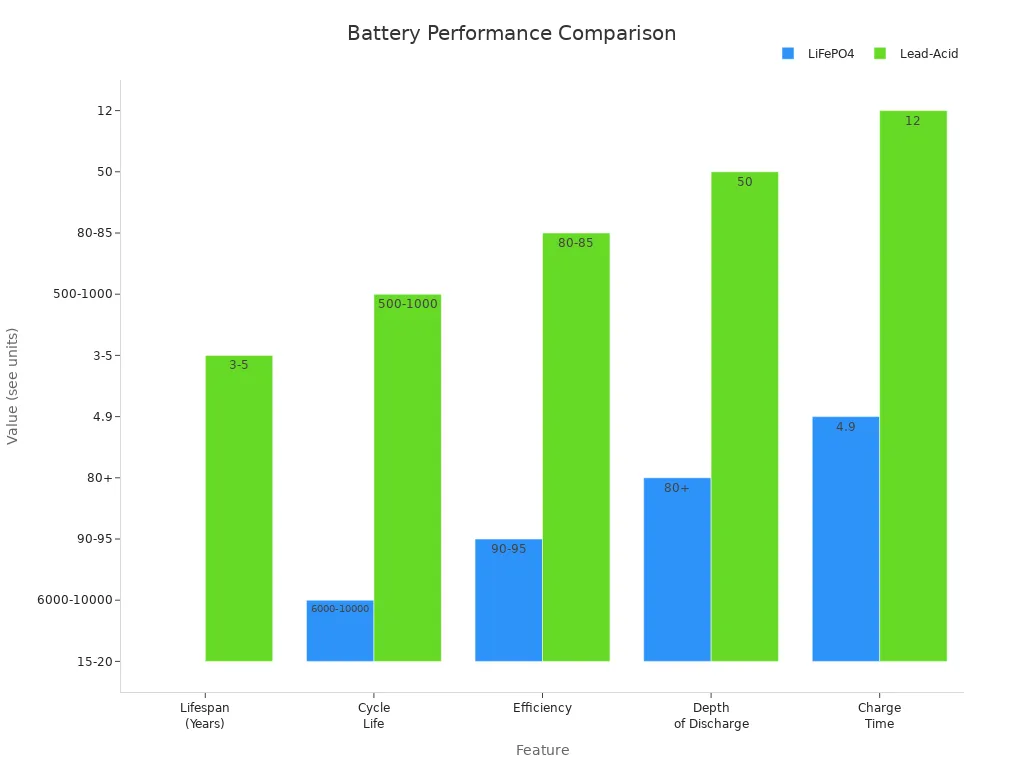
Pick a battery that matches your setup for the best results. If you want dependable, high-performance lighting, Rackora’s solar solutions deliver safety, durability, and peace of mind.
FAQ
How do I know if my solar light supports a large-capacity external battery?
Check your solar light’s manual or label. Look for battery type, voltage, and maximum capacity. If you see “LiFePO4” or “25AH” listed, you’re good to go. When in doubt, contact the manufacturer or Rackora’s support team.
Will a bigger battery make my solar light brighter?
A bigger battery lets your light run longer at full brightness. It won’t make the LEDs brighter than their rated output, but it keeps the light from dimming as the night goes on.
Can I use any external battery with my solar light?
No, you can’t use just any battery. You need to match the voltage, chemistry, and connector type. Using the wrong battery can damage your light or reduce performance. Always check compatibility first.
How long does a Rackora 25AH LiFePO4 battery last?
You can expect up to 5–7 days of continuous lighting, even during cloudy weather. The battery itself can last 10 years or more with proper care. That means less hassle and fewer replacements for you.
What maintenance do large-capacity solar batteries need?
You don’t need much maintenance. Just keep the battery and solar panel clean and dry. Check connections every few months. Replace the battery when you notice shorter run times or dimmer lights.
Are large-capacity batteries safe to use outdoors?
Yes! Quality batteries like Rackora’s 25AH LiFePO4 come with waterproof cases and built-in protection. They handle rain, dust, and temperature swings. You can trust them for outdoor use year-round.
Can I upgrade my existing solar light with a bigger battery?
You can upgrade if your light’s circuitry supports higher capacity. Check the specs or ask the manufacturer. If you use a Rackora system, swapping batteries is easy—no special tools needed.
